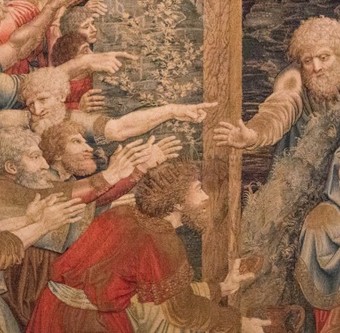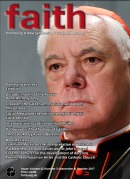
The Rosary
Donal Anthony Foley
In this, the Centenary year of the Fatima apparitions, which took place between May and October 1917, it is good to remind ourselves of the essential points which the Our Lady spoke of to the young seers, Jacinta and Francisco Marto, and Lucia dos Santos. One of the most important of these was the particular focus she had on the rosary, and in fact, on every one of her six apparitions she specifically asked for the rosary to be said. This aspect of her message could not have been more emphatic.
On 13 May 1917 she said, “Pray the rosary every day to obtain peace for the world and an end to the war,” and these twin themes were repeated by her over the summer, culminating in her 13 October apparition when she said, “I am the Lady of the rosary. Continue always to pray the rosary every day.”
Why this focus on the rosary? For her to emphasize it in this way must mean it has an extraordinary power with God, and this is just what history tells us. We could cite incidents from centuries ago, such as the defeat of the Albigensian heresy by St. Dominic through the power of the rosary, or the victory gained at the battle of Lepanto in 1571, again through the power of the rosary.
But we don’t have to go back so far to see it’s great efficacy. In fact this was demonstrated very effectively as recently as 1955, when, following World War II, the occupying Soviet Army voluntarily left the Eastern zone of Austria. Fr Petrus Pavilcek, a Franciscan, had organized a rosary Crusade from 1946 onwards, which eventually had ten percent of the population of 7 million praying five decades of the rosary daily for peace in the country. He also organized candlelit processions in Vienna with a pilgrim Virgin statue of Our Lady from Fatima.
On 13 May 1955, it was announced that the Soviets were willing to withdraw from Austria and sign a peace treaty. This was the only time in the history of the Soviet Union that the Red Army voluntarily withdrew from a European country it had occupied without firing a shot. And it happened on the anniversary of the first Fatima apparition. In contrast, though, the attempted revolutions in Hungary, in 1956, and Czechoslovakia, in 1968, were brutally put down.
And even more recently, in Brazil in the 1960s and Portugal in the 1970s, the power of the rosary was again demonstrated when incipient communist coups in both countries were thwarted, when large numbers of women in both countries prayed the rosary publicly as a protest against the threats their countries faced.
These historical incidents show that while it is good to pray the rosary as an individual, it is much more powerful if we pray it as part of a group.
This was the teaching of St Louis de Montfort, who said that if we pray the rosary in a group, then we multiply it's effectiveness. That is, if a person says a rosary, that is just one rosary, but if, for example, ten people pray it together, that is the same as if each of them has said ten rosaries each – and this multiplying effect becomes even more powerful with larger numbers, and hence the explanation for the power of all those rosaries said in Austria.
In fact, what is really needed in Britain and in countries around the world generally, are National Rosary Pledge campaigns, like the one organized by Fr Pavlicek in Austria. If believers started to pray the rosary regularly for the moral regeneration of our country, then we would start to see real changes. This is because such prayer would call down graces of conversion that would lead to lapsed Catholics returning to the practice of their faith, and to a general revitalization of the Church.
But at the same time we have to live the Message of Fatima as fully as we can, in line with the teaching of recent Popes.
It should also be remembered that the devil is terrified of the power of the rosary. In his book, The Last Exorcist, Fr. Gabriel Amorth reports how “During an exorcism, Satan told me, through the possessed person, ‘Every Hail Mary of the rosary is a blow to the head for me; if Christians knew the power of the rosary, it would be the end of me!’ ”
So that is another good reason to say the rosary!
During his 1982 visit to Fatima, a year after the failed attempt on his life on 13 May 1981, Pope John Paul II said, “If the Church has accepted the message of Fatima, it is above all because that message contains a truth and a call whose basic content is the truth and call of the Gospel itself.” He further stated that the, “appeal of the Lady of the message of Fatima is so deeply rooted in the Gospel and the whole of Tradition that the Church feels that the message imposes a commitment on her.”
These are very powerful words and indicate just how important the Fatima message really is. We can understand this more fully if we reflect on the Collegial Consecration carried out by the Pope and the bishops of the world in March 1984, which led to the collapse of Communism in Eastern Europe and the peaceful dissolution of the Soviet Union.
Following this consecration, Sr. Lucia was visited by the Apostolic Nuncio, and she confirmed that the consecration of Russia had indeed been accomplished, and that God had accepted it. In Russia, on the death of Chernenko, on 11 March 1985, Mikhail Gorbachev became General Secretary of the Communist Party. He became President in 1988, and that was the beginning of the unravelling of the Soviet colossus.
The unexpected peaceful outcome of John Paul II’s consecration of 1984 averted the threat of another war in Europe, and validates Sr Lucia’s plea just before the outbreak of the second World War, on 20 March 1939. She said then that, “World War or world peace depends on the practice of the devotion of the first Saturdays as well as the consecration to the Immaculate Heart of Mary; that is why I wish for its propagation and most of all because that is Our God’s will and also our dearest Heavenly Mother’s.”
The First Saturdays devotion referred to above prompted a further apparition to Lucia in 1925. By this time she was a postulant with the Sisters of St. Dorothy at Pontevedra in Spain. On Thursday 10 December, the Blessed Virgin, accompanied by the Child Jesus on a little cloud, appeared to her in her cell. Lucia recounted that Mary rested her hand on her shoulder, while showing her a heart encircled by thorns in her other hand.
The Child Jesus spoke first. “Have pity on the Heart of your Most Holy Mother. It is covered with the thorns with which ungrateful men pierce it at every moment, and there is no one to remove them with an act of reparation.”
Then Mary said, “My daughter, look at My Heart surrounded with thorns with which ungrateful men pierce it at every moment by their blasphemies and ingratitude. You, at least, try to console me, and say that I promise to assist at the hour of death, with all the graces necessary for salvation, all those who, on the first Saturday of five consecutive months go to confession and receive Holy Communion, recite five decades of the rosary and keep me company for a quarter of an hour while meditating on the mysteries of the rosary, with the intention of making reparation to me.”
From this it seems appropriate to say that the First Saturdays devotion is an “extension” of the rosary, since it is based around its prayerful recitation. This again shows the importance of the rosary as a core element of the Fatima message.
The above facts have important consequences for the Church. If Catholics are saying the rosary regularly with devotion then that in itself brings down important heavenly graces on them and their families – and at the same time, as Our Lady said, it is the means she gives us to bring about peace in the world.
Regarding the Five First Saturdays devotion, this, if implemented on a sufficiently wide enough scale, would be an excellent form of re-evangelisation, one that would bring people to live their faith more fully through regular reception of the Church’s sacramental sources of grace, with the assurance of Our Lady’s promise to assist them at the hour of death “with all the graces necessary for salvation”.
This means that it is important that both rosary groups and the Five First Saturdays are started in as many parishes as possible. This will further devotion to Our Lady and Fatima, and ultimately, also bring about the conversion of Russia and the renewal of the Church.
Recent Popes have been urging the Church to take the Message of Fatima seriously. For example, at the Mass in St Peter’s on 13th May 2006, to commemorate the 25th anniversary of the attempt on the life of Pope Saint John Paul II, Pope Benedict XVI expressed the hope that “the message of
Fatima will be increasingly accepted, understood and lived in every community.” And in Fatima, on 13 May 2010, he said: “We would be mistaken to think that the prophetic mission of Fatima is complete.”
John Paul II was responsible for the promulgation of the Luminous Mysteries of the rosary in 2002, in an attempt to broaden its appeal by focusing on aspects of Christ’s public ministry. These new mysteries were introduced in the Pope’s encyclical letter, Rosarium Virginis Mariae, in which he emphasised the importance of praying the rosary for Catholics, saying:
“The rosary, though clearly Marian in character, is at heart a Christocentric prayer. In the sobriety of its elements, it has all the depth of the Gospel message in its entirety, of which it can be said to be a compendium. It is an echo of the prayer of Mary, her perennial Magnificat for the work of the redemptive Incarnation which began in her virginal womb. With the rosary, the Christian people sits at the school of Mary and is led to contemplate the beauty on the face of Christ and to experience the depths of his love. Through the rosary the faithful receive abundant grace, as though from the very hands of the Mother of the Redeemer.”
Pope Francis, too, has taken Fatima seriously, ensuring that his pontificate was consecrated to Our Lady of Fatima on 13 May 2013, by the Cardinal of Lisbon. And during the Marian celebrations held in Rome on 12th and 13th October 2013, the Pope entrusted the world to the Immaculate Heart of Mary.
All of the above are very significant events, and they show that Pope Francis is maintaining the close links between the Papacy and Fatima. And now, just a few months ago, Jacinta and Francisco were canonized by him in Fatima, on 13 May 2017.
The centenary year of Fatima is a renewed call for us all to accept the Message given by Our Lady at Fatima, and in particular to do what we can to live and promote the rosary and the Five First Saturdays devotion.
Notes:
Donal Anthony Foley is the secretary of the World Apostolate of Fatima England and Wales The National Pilgrim Virgin Statue of Our Lady of Fatima and Relics of Saints Jacinta and Francisco are currently visiting Cathedrals and churches around the country – details can be seen here: https://www.worldfatima-englandwales.org.uk/visitation.html





